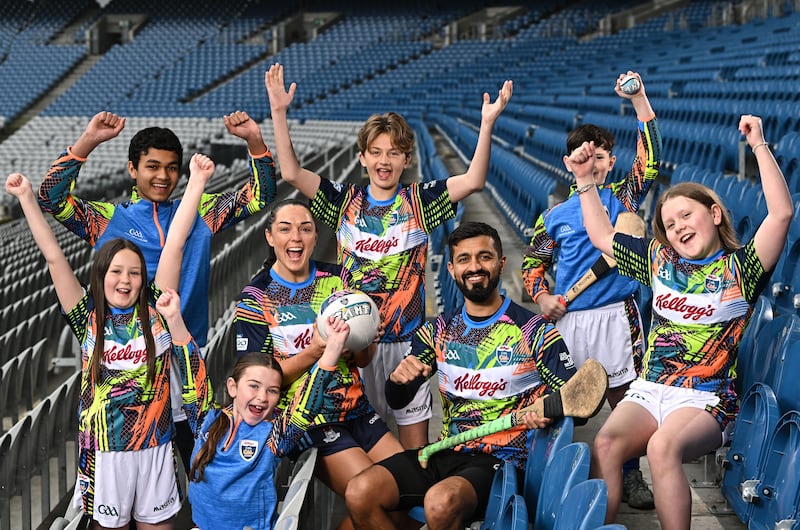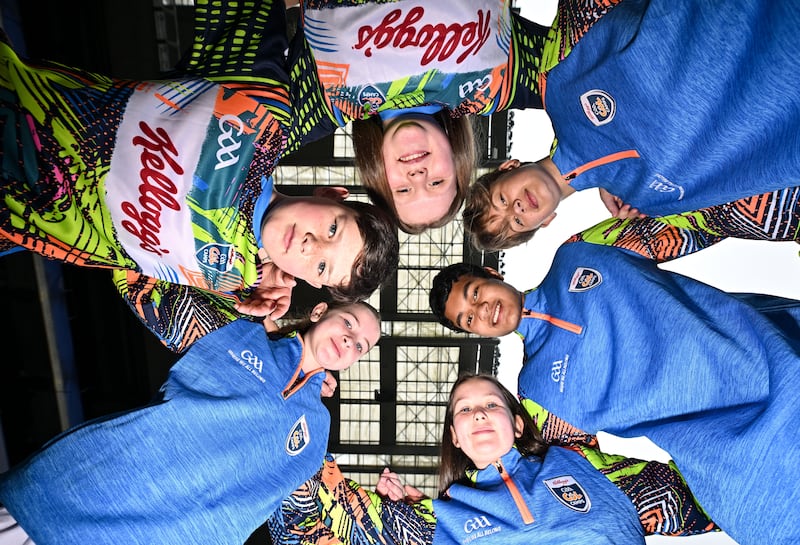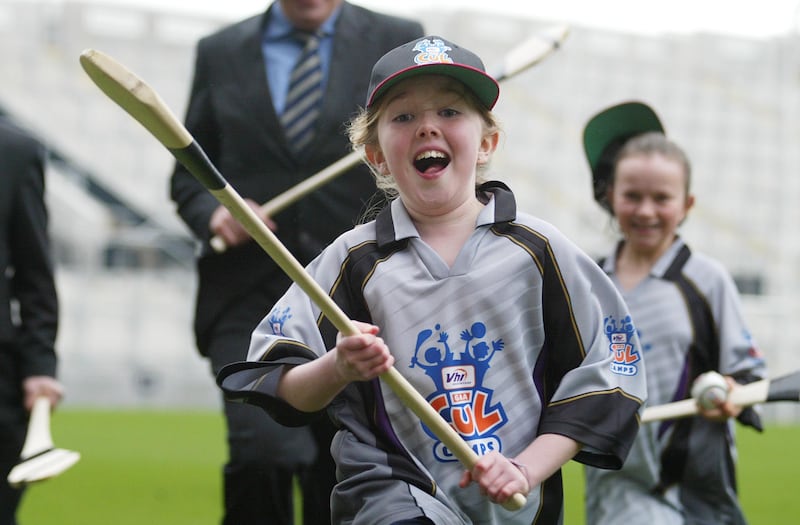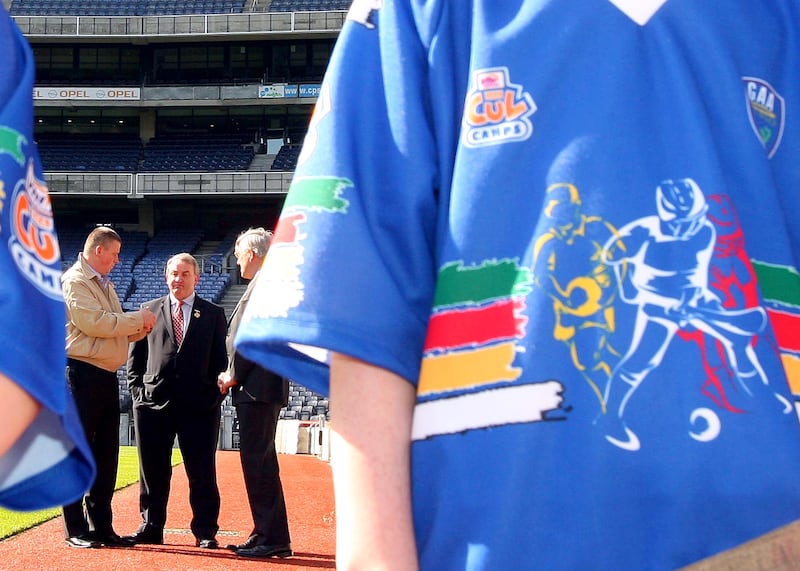The eight-year-old burst through the kitchen door in a blind panic last week. He was dragging one partially negotiated football sock along the floor behind him like a mop, while the other mimicked a faceless hand-puppet yanked up along his arm. His shorts were on back to front.
Clearly, things were not cool. Not Cúl at all.
In a wardrobe malfunction entirely Irish in its subject matter, his GAA Cúl Camps quarter-zip top was nowhere to be found. And woe betide but how could one possibly entertain the idea of going training without it? So, he had hurried down the stairs to round up a search party.
Not that Poirot was going to be needed to solve the mystery – for it resides in one of only three places: on him, in the washing machine or in his wardrobe. And, let’s be honest, as garments go those tops are hard to miss. Subtle, they ain’t.
READ MORE
The phenomenon of the GAA Cúl Camps gear is a fad that is fast evolving into a cultural touchstone. It has become a uniform of Irish summers that spills over to Irish autumns, winters and springs. And as with any popular legacy clothing range, it has got a strong back catalogue too.
There have been 12-year-olds who on spotting one of their peers kitted out in apparel from a vintage Cúl Camps season would sidle up alongside and nod assertively: “2019 ... I was there too, kid. A good year for bags but the tops from the 2018 collection have never been topped.”
If you were fortunate enough to get away for a break over the summer, the omnipresence of the gear won’t have gone unnoticed. From Dingle to Donegal, from Cambrils in northeast Spain to any of the myriad of family campsites dotted across northwest France, nowhere escaped.
Such was the proliferation of the jerseys and zip tops and backpacks on certain ferry crossings this summer that overseas visitors would have been forgiven for assuming the army of little people bombing around deck were actually part of the crew, all helpfully kitted out in the same garish bright tops so as to be easily identifiable should one require assistance. Good luck with that!
There must be fashion houses bamboozled and confounded at the saturation and reach achieved by these brash, zany multicoloured pieces of clothing and bags that undoubtedly were designed by a process of randomly flinging as many colours as possible at a template, while blindfolded, and instantly agreeing such a work of art could not be bettered, so why bother even trying.


The unlikely outcome has been pieces of clothing that are fun for kids and functional for parents (sure don’t they wash great!).
Seán Kelly was the GAA president when the association decided to take ownership of the summer camps. Prior to that, there had been a hint of the wild west around the space as GAA units organised individual camps. Eventually, they had been pulled together on a provincial basis but to maximise the product it needed centralisation.
So, in Croke Park on January 16th, 2006, Kelly officially unveiled Cúl Camps – the association’s first national summer camps for kids between the ages of six and 13.
With VHI Healthcare as maiden sponsor, 66,185 children attended camps in that first year.
“We felt strongly it was going to be a success,” recalls Kelly. “But being honest, did we think it was going to grow to where it is now with almost every club in the country involved? Not a hope on Earth.”
In 2015 the figure broke the 100,000 mark for the first time when 102,384 kids attended.
This summer 144,494 children – boys and girls – pitched up at one of the 1,300 Cúl Camps across the country. With over 7,000 coaches involved, it is a truly gargantuan undertaking.
The Cúl Camps generate about€10 million per year – after the costs of manufacturing the gear, its delivery, paying the coaches and everything else associated with facilitating such an operation, the GAA aims to break even.
But in terms of marketing and brand awareness, the sheer visibility of the gear in everyday life is priceless.
“There is nothing accidental about its success; by bringing the camps together under one umbrella, it gave the GAA something they could then take to commercial partners,” explains Kelli O’Keeffe, managing director of sports advisory practice Teneo Ireland.
Kellogg’s took over the sponsorship for the 2012 camps and have remained the title sponsor since. It is estimated it pays in the region of €400,000 per year.
“It is one of the most coveted sponsorship opportunities in Ireland,” adds O’Keeffe.
“It gives you access to a notoriously difficult group to reach. And with the tops and bags, you then have nearly 150,000 walking billboards that don’t just last an advertising cycle, they last a full year until the next camp comes around.”

Since covid, the packs are posted out – at a cost of €75 for the first child (€60 for the second and €50 per kid thereafter) Cúl Campers this summer received a jersey, quarter-zip top and a backpack. All decorated in that distinctive mishmash of colours.
And who chooses the design of the gear? Well, the kids.
Former Carlow footballer Seán Gannon has been National Cúl Camps co-ordinator since early 2022. He succeeded ex-Sligo player Charlie Harrison.
A design tender is sent out to clothing and apparel companies annually. They reply with samples and from around 30 to 40 designs, Gannon cuts the number down to roughly half a dozen options.
And then he takes those samples on the road to Cúl Camps and polls in the region of 1,500-2,000 children to find their favourite.
“At this year’s camps, kids would have voted on their favourite for next year,” says Gannon.

“The kids will decide which design it should be for the following year – we go with the most popular.”
That design then goes to tender to determine who will manufacture the product – given the volume required it is done on a weighted scale, so for instance in 2024 both Azzurri and Masita produced gear.
“I think that’s part of the magic of the kit – it was chosen by kids for kids,” says Sarah Ferguson, general manager of Kellanova Ireland, parent company of Kellogg’s.
Kelly, in his role as a member of the European Parliament, has become accustomed to spotting the gear on his travels. He is also honorary president of Belgium GAA, which was one of 30 clubs outside of Ireland to host a Cúl Camp in 2024.
“It gives me great delight seeing the gear, you’d nearly be wanting to go over to ask the kid: ‘Where are you from, what’s your club?’ From where it started, it’s fantastic,” says the former GAA president.
Gear-spotting is real.
“It’s unavoidable,” adds Ferguson. “I’ve seen backpacks on everyone from parents to grandparents. And sometimes you see families with the archive of Kellogg’s GAA Cúl Camps kits where each child is wearing one from a different year.”
The record attendance was in 2019 when 156,175 kids took part in camps, which prompted Director General Tom Ryan to write in his subsequent annual report that those figures consolidated the GAA’s “position as operating the single biggest Child Sport Promotion in the world”.

This summer there were 37 Inclusion Camps for kids with additional needs. Some 600 free places were also provided to the School Completion Programme across the island, for children who would otherwise find it difficult to attend the camps.
The camps had to be stripped back for the covid-impacted summer of 2020 where a reduced number hosted 71,000 kids, but it has grown again in the years since.
The 2023 figure of 146,460 represented 18.5 per cent of the population aged between six and 13. However, having analysed the demographics in relation to that age bracket, the GAA feels maintaining those numbers could be challenging in the years ahead.
The eight-year-old attended several other camps during the summer too – the FAI and Leinster Rugby offerings also proved very popular (a football, pencil case, water bottle, string sack and T-shirts were mined from those).
Indeed, because of all the goody-bag paraphernalia, it would be easy to forget the central idea of these camps is for kids to have fun while learning and improving on the skills of a particular sport.
But there is no escaping a sense the gear from the GAA camps has become a badge of identity for many kids. It’s a Cúl Cult!
“Since the GAA moved to a multi-sponsor model at senior level, there are fewer highly coveted naming rights opportunities,” adds O’Keeffe.

“So based on the numbers that attend and the community aspect of it, it has to be one of the highest-profile naming rights sponsorships the GAA has.”
As for next year’s offering, the design of the gear has already been decided.
“The kit is picked and is being manufactured at the moment,” says Gannon.
“Look, no matter what design is chosen it won’t please everybody, but we try our best. That’s why we ask the children. And for those who don’t like it, I always get the blame the following year anyhow!”
But he probably shouldn’t worry too much, the Cúl Camps gear tends to be a cereal winner.
CÚL CAMPS
2006 – first year of the Cúl Camps; attendance: 66,185
2015 – breaks through the 100,000 mark for the first time; attendance: 102,384
2019 – Record number of kids at camps; attendance: 156,175
The last five years:
2020 – 71,000
2021 – 137,989
2022 – 142,030
2023 – 146,460
2024 – 144,494
♦ 2023 figure of 146,460 represented 18.5 per cent of the population aged between six and 13
♦ 2024 in numbers – 1,300 Cúl Camps; 7,000 coaches; 144,494 attendees
- Sign up for push alerts and have the best news, analysis and comment delivered directly to your phone
- Join The Irish Times on WhatsApp and stay up to date
- Listen to our Inside Politics podcast for the best political chat and analysis






















